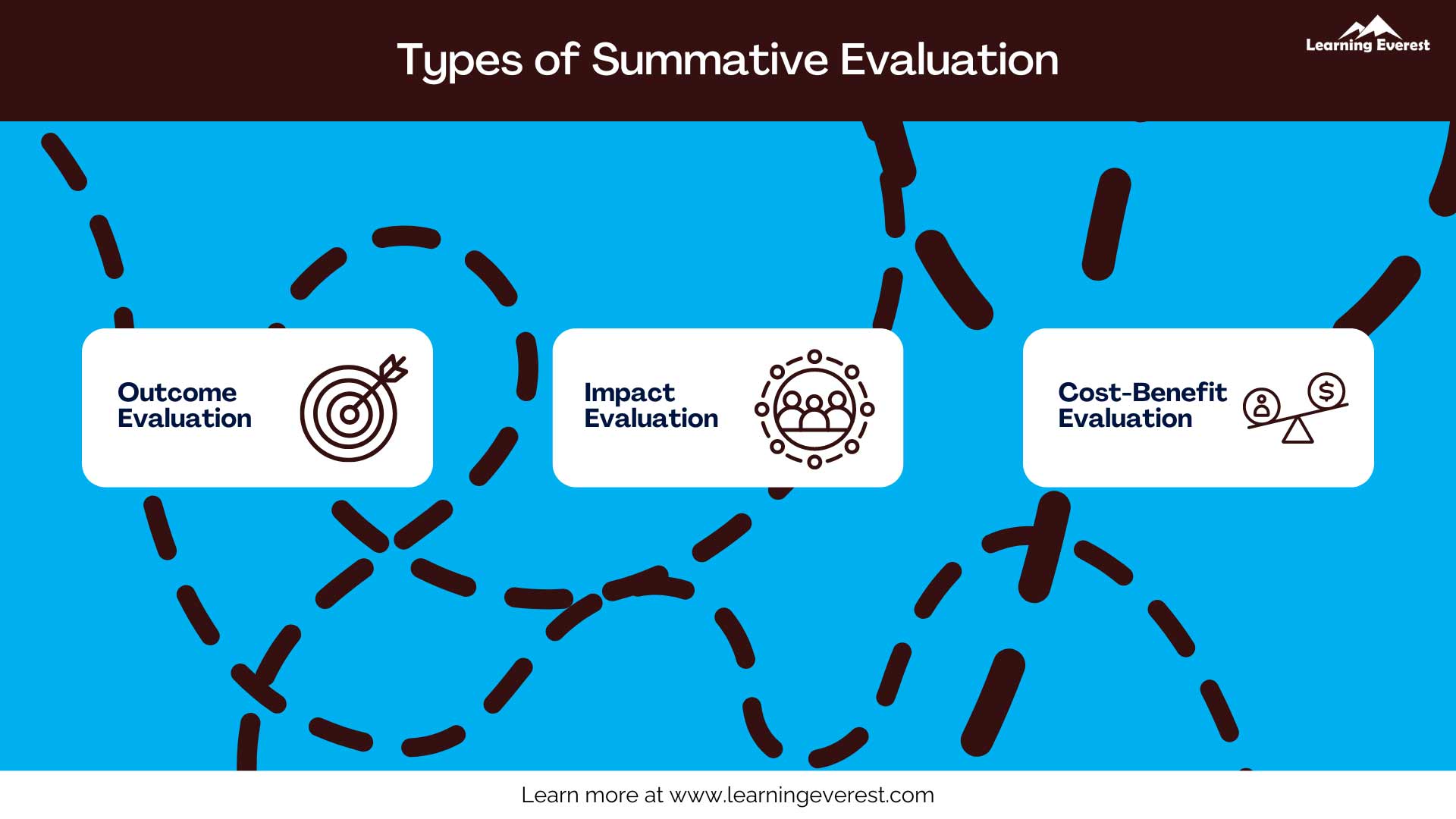Summative evaluation is an important tool for assessing the outcome and impact of a learning initiative. It is used universally in various learning contexts from school classrooms to corporate training programs. Summative evaluation provides vital information about how a learning program fared, enabling well-informed decisions for improvement. This article will give you a quick breakdown of what summative evaluation is, its uses, and its methods.
Table of Contents
- What is summative evaluation?
- Types of Summative Evaluation
- Summative Evaluation Methods
- Benefits of Summative Evaluation
- Limitations of Summative Evaluation
- Summative Evaluation in eLearning
- Conclusion
- Infographic
- Knowledge Check!
- Frequently Asked Questions (FAQs)
- What is meaning of summative evaluation?
- What is an example of summative evaluation?
What is summative evaluation?
Summative evaluation is an evaluation that occurs at the end of a training program. It assesses the overall effectiveness of the training program and whether the learning objectives and goals of the learning initiative have been met. Additionally, it serves as a measure of learners’ success or failure in the program and is used to provide grades, scores, etc.
Based on the information gathered from the summative evaluation, important decisions about the training program are made, such as:
- Future funding and budgeting for the program
- Potential improvements in the program’s training techniques and delivery
- Potential improvements in which aspects of the program to assess
- Any changes in the curriculum to be made
Hence, summative evaluation is crucial to training and development and serves necessary functions for the overall success and effectiveness of training programs.
Types of Summative Evaluation

Types of Summative Evaluation
Given the various goals of summative evaluation, it can be of one or multiple types. Some common types are:
- Outcome evaluation: Outcome evaluation measures tangible project outcomes, like behavioral change, knowledge acquisition, and changes in attitude.
- Impact evaluation: Impact evaluation assesses the broader influence a learning intervention has on an organization, department, community, etc.
- Cost-benefit evaluation: Cost-benefit evaluation seeks to determine whether the benefits of the program warranted, made up for, and outweighed its costs.
Summative Evaluation Methods
There are many different ways to conduct a summative evaluation. The strategies you pick will depend on your sample size, the kind of program, and the kind of information that you are seeking to gather.
- Standardized tests: These tests are meant to assess learners against a certain pre-established benchmark of performance, i.e., they follow a pre-determined standard. Standardized tests are fair and objective, with each student’s responses graded based on the same criteria.
- Surveys: Surveys are multiple-choice questionnaires that seek to gather information about learners’ beliefs, attitudes, and opinions on a course. They are useful tools for gauging parameters such“ as engagement, experience, impressions, etc.
- Questionnaires: Questionnaires are similar to surveys but are more suited to test learners’ knowledge acquisition.
- Presentations: Presentations require learners to research topics and present them to an audience individually or as a group. With presentations, learners become more familiar with the intricacies and applications of the subject matter. Additionally, they are a good way to assess learners’ grasp on the topic and make for an effective summative assessment strategy.
- Focus group interviews: Focus group interviews are discussions geared at collecting feedback and experiences from target audiences or stakeholders about a learning program. Focus groups provide crucial information about how a learning program is received and experienced by users, and which areas learners are satisfied and dissatisfied with.
- Projects: Lastly, projects can serve as form of summative evaluation. Projects involve a series of tasks and activities that learners need to complete in order to achieve a final, tangible outcome. Projects facilitate the application of knowledge and serve as a measure for whether learners built actionable skills in a training program or not.
Benefits of Summative Evaluation
Now that you know what summative evaluation is and how it can be conducted, let us look at its benefits.
Summative evaluations are a common practice at the end of learning initiatives, and for good measure. Here are some benefits of summative evaluation that have made them a mainstay in learning and development:
- Generates feedback for learners: With summative evaluations, learners get
- Identifies areas for improvement: Summative evaluations help identify aspects of a training program that need improvement. This could be in terms of delivery, content, hardware and software requirements, design, accessibility, etc.
- Enables data-driven decision-making: Summative evaluations provide robust data about learning programs, enabling data-driven decision-making. This ensures that all decisions are strategic and guarantee meaningful improvements and troubleshooting.
- Measure impact: Without summative evaluations, it is difficult to quantify and pinpoint the impact of a learning program. This can lead to unwanted outcomes, such as maintaining an ineffective status quo, providing programs that don’t achieve their desired outcomes, and ineffective allocation of resources to different programs. Impact also gives credibility to programs, ultimately increasing its value in the eyes of learners, leading to more effective and serious learning.
- Increases accountability and transparency: When learning programs are evaluated regularly, it increases learners’ and project members’ accountability. It also promotes transparency in processes and use of resources, ensuring that all supplies are used to their best potential.
Inform policies: Summative evaluation can also play a role in informing learning policies by providing crucial information about what works and what doesn’t, learners’ needs, etc.
Limitations of Summative Evaluation
While summative evaluation is necessary and beneficial, it does have a few limitations that should be accounted for and mitigated whenever possible.
- Can cause stress and anxiety: Summative evaluation might put a damper on learning for some learners due to the stress and anxiety of an eventual assessment. Additionally, the higher the stakes get, the more stress and anxiety are likely to be caused. Such emotions and mental states can counteract and decrease the effectiveness of learning programs.
- Can limit creativity: Evaluation methods such as standardized tests might limit learners’ creativity in exploring the bounds of the knowledge and skills they acquire through learning. This in turn has the potential to impact learning design as a whole, and make the learning experience less engaging than it has the potential to be.
- Inaccurate measure of learning: If not designed carefully, summative evaluation might measure the wrong aspects of learning, ultimately defeating the purpose of the evaluation.
Summative Evaluation in eLearning
While summative evaluation is used widely in face-to-face learning settings such as classrooms, it can also easily be adapted to eLearning. Let us look at some ways in which this can be done:
- End-of-lesson quizzes: One of the most common ways to conduct summative assessments in eLearning is through end-of-lesson quizzes.
- Projects: It is also possible to assign individual or group projects to learners that they can submit at the end of the program, through a portal or an LMS.
- Presentations: It is also possible to conduct presentations in eLearning courses. These can be pre-recorded submissions by learners or live presentations in a virtual classroom through video conferencing platforms.
- Surveys: Surveys are another great tool for conducting summative evaluations in an eLearning setting.
Typically, a mixture of different approaches is used to make the summative evaluation as thorough as possible. There are many other summative evaluation approaches that can be used. As mentioned before, it is important to pick the right strategies so that the data you gather provides valuable insights into your learning program.
Conclusion
Summative evaluation is an important part of a learning program’s lifecycle and plays a crucial role in measuring impact and making improvements. While summative assessment has many benefits, it also should be used strategically to get the most out of it.
Infographic
Knowledge Check!
Frequently Asked Questions (FAQs)
What is meaning of summative evaluation?
Summative evaluation is an evaluation that occurs at the end of a training program. It assesses the overall effectiveness of the training program and whether the learning objectives and goals of the learning initiative have been met.
What is an example of summative evaluation?
Standardized tests are a common example of summative evaluation.






